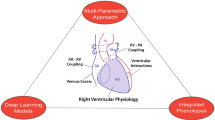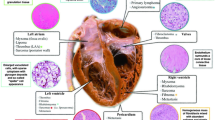Abstract
Epicardial interventions have forged new frontiers in cardiac ablation and device therapies. Healthy human hearts typically present with significant adipose tissue layers superficial to the ventricular myocardium and may hinder success or increase the complexities of epicardial interventions. We quantitatively evaluated the distribution of epicardial adipose tissue on the surface of human hearts and provided high-fidelity 3-dimensional reconstructions of these epicardial adipose tissue layers. The regional thickness of adipose tissues was analyzed at 51 anatomical reference points surrounding both ventricles and compared to specific patient demographics. Adipose deposits on the human hearts displayed characteristic patterns, with the thickest accumulations along the interventricular septa (anterior, 9.01 ± 0.50 mm; posterior, 6.78 ± 0.50 mm) and the right ventricular margin (7.44 ± 0.57 mm). We provide one of the most complete characterizations of human epicardial adipose location and relative layer thickness. These results are considered fundamental for an underlying anatomic understanding when performing procedures within the pericardial space.
Graphical Abstract
The relative thickness of epicardial adipose tissue was analyzed across 80 human hearts, with a subset displayed here as 3D reconstructions with thinner to thicker adipose regions indicated by a relative green-to-red color scale.







Similar content being viewed by others
Data Availability
The datasets generated during and/or analyzed during the current study are available from the corresponding author on reasonable request.
Abbreviations
- CABG:
-
Coronary artery bypass graft
- LV:
-
Left ventricle
- LVAD:
-
Left ventricular assist device
- RF:
-
Radiofrequency
- RV:
-
Right ventricle
- RVOT:
-
Right ventricular outflow tract
References
Sosa E, Scanavacca M, D’Avila A, Pilleggi F. A new technique to perform epicardial mapping in the electrophysiology laboratory. J Cardiovasc Electrophysiol. 1996;7:531–6.
D’Avila A, Houghtaling C, Gutierrez P, et al. Catheter ablation of ventricular epicardial tissue. Circulation. 2004;109:2363–9.
Desjardins B, Morady F, Bogun F. Effect of epicardial fat on electroanatomical mapping and epicardial catheter ablation. J Am Coll Cardiol. 2010;56:1320–7.
Shirani J, Berezowski K, Roberts WC. Quantitative measurement of normal and excessive (cor adiposum) subepicardial adipose tissue, its clinical significance, and its effect on electrocardiographic QRS voltage. Am J Cardiol. 1995;76:414–8.
Rabkin SW. Epicardial fat: properties, function and relationship to obesity. Obes Rev. 2007;8:253–61.
Tansey DK, Aly Z, Sheppard MN. Fat in the right ventricle of the normal heart. Histopathology. 2005;46:98–104.
Wu FZ, Chou KJ, Huang YL, et al. The relation of location-specific epicardial adipose tissue thickness and obstructive coronary artery disease: systemic review and meta-analysis of observational studies. BMC Cardiovasc Disord. 2014;14:62.
Chung JH, Kwon BJ, Song SW, et al. Epicardial adipose tissue: relationship between measurement location and metabolic syndrome. Int J Cardiovasc Imaging. 2014;30:195–204.
Mattson AR, Soto MJ, Iaizzo PA. The quantitative assessment of epicardial fat distribution on human hearts: implications for epicardial electrophysiology. Clin Anat. 2018;31:661–6.
Nelson AJ, Worthley MI, Psaltis PJ, et al. Validation of cardiovascular magnetic resonance assessment of pericardial adipose tissue volume. J Cardiovasc Magn Reson. 2009;11:15.
Mahajan R, Kuklik P, Grover S, et al. Cardiovascular magnetic resonance of total and atrial pericardial adipose tissue: a validation study and development of a 3 dimensional pericardial adipose tissue model. J Cardiovasc Magn Reson. 2013;15:73.
Silaghi A, Piercecchi-Marti MD, Grino M, et al. Epicardial adipose tissue extent: relationship with age, body fat distribution, and coronaropathy. Obesity. 2008;16:2424–30.
Okada K, Ohshima S, Isobe S, et al. Epicardial fat volume correlates with severity of coronary artery disease in nonobese patients. J Cardiovasc Med. 2014;15:384–90.
Nerlekar N, Brown AJ, Muthalaly RG, et al. Association of epicardial adipose tissue and high-risk plaque characteristics: a systematic review and meta-analysis. J Am Heart Assoc. 2017;6:e006379.
Rosito GA, Massaro JM, Hoffmann U, et al. Pericardial fat, visceral abdominal fat, cardiovascular disease risk factors, and vascular calcification in a community-based sample. Circulation. 2008;117:605–13.
Gorter PM, van Lindert ASR, de Vos AM, et al. Quantification of epicardial and peri-coronary fat using cardiac computed tomography; reproducibility and relation with obesity and metabolic syndrome in patients suspected of coronary artery disease. Atherosclerosis. 2008;197:896–903.
Gonzalez-Suárez A. Mathematical modeling of epicardial RF ablation of atrial tissue with overlying epicardial fat. Open Biomed Eng J. 2010;4:47–55.
Dixit S, Narula N, Callans DJ, Marchlinski FE. Electroanatomic mapping of human heart: epicardial fat can mimic scar. J Cardiovasc Electrophysiol. 2003;14:1128–1128.
Becker M, Altiok E, Ocklenburg C, et al. Analysis of LV lead position in cardiac resynchronization therapy using different imaging modalities. JACC Cardiovasc Imaging. 2010;3:472–81.
Tonko JB, Rinaldi CA. Non-traditional implantable cardioverter-defibrillator configurations and insertion techniques: a review of contemporary options. Europace. 2022;24:181–92.
Roest S, Budde RPJ, Brugts JJ, et al. Epicardial fat volume is related to the degree of cardiac allograft vasculopathy. Eur Radiol. 2023;33:330–8.
Khush KK, Cherikh WS, Chambers DC, et al. The International Thoracic Organ Transplant Registry of the International Society for Heart and Lung Transplantation: Thirty-sixth adult heart transplantation report — 2019. J Heart Lung Transplant. 2019;38:1056–66.
Rao VN, Obeid MJ, Rigiroli F, et al. Pericardial adipose tissue volume and left ventricular assist device-associated outcomes. J Card Fail. 2022;28:149–53.
Terada T, Johnson JA, Norris C, et al. Severe obesity is associated with increased risk of early complications and extended length of stay following coronary artery bypass grafting surgery. J Am Heart Assoc. 2016;5:e003282.
Hartrumpf M, Kuehnel RU, Albes JM. The obesity paradox is still there: a risk analysis of over 15,000 cardiosurgical patients based on body mass index. Interact Cardiovasc Thorac Surg. 2017;25:18–24.
Lv M, Gao F, Liu B, et al. The effects of obesity on mortality following coronary artery bypass graft surgery: a retrospective study from a single center in China. Med Sci Monit. 2021;27:e929912.
Iacobellis G. Epicardial adipose tissue in contemporary cardiology. Nat Rev Cardiol. 2022;19:593–606.
Sacks HS, Fain JN. Human epicardial adipose tissue: a review. Am Heart J. 2007;153:907–17.
Acknowledgements
We are extremely grateful to the individuals and their families who donated their bodies to science. We would like to thank Susan Sun and Traci Jones for their help with data collection and Monica Mahre for helping prepare this manuscript for publication.
Funding
This work was supported, in part, with a research contract from Medtronic (Minneapolis, MN) and the University of Minnesota’s Institute for Engineering in Medicine. The sponsors had no role in study design, data collection/analysis/interpretation, report writing, or decision to submit for publication.
Author information
Authors and Affiliations
Corresponding author
Ethics declarations
Human Subjects
LifeSource secured consent from donors or their families to use organs for research. The Institutional Review Board at the University of Minnesota granted exemption from ethics approval, being the heart specimen was considered waste tissue donated for medical research.
Animal Studies
No animal studies were carried out by the authors for this article.
Conflict of Interest
PA Iaizzo has a research contract and educational consulting role with Medtronic. AR Mattson is employed by Medtronic. RC Brigham has no disclosures to report.
Additional information
Associate Editor Nicola Smart oversaw the review of this article
Publisher's Note
Springer Nature remains neutral with regard to jurisdictional claims in published maps and institutional affiliations.
Supplementary Information
Below is the link to the electronic supplementary material.
Rights and permissions
Springer Nature or its licensor (e.g. a society or other partner) holds exclusive rights to this article under a publishing agreement with the author(s) or other rightsholder(s); author self-archiving of the accepted manuscript version of this article is solely governed by the terms of such publishing agreement and applicable law.
About this article
Cite this article
Brigham, R.C., Mattson, A.R. & Iaizzo, P.A. Ventricular Epicardial Adipose Distribution on Human Hearts: 3-Dimensional Reconstructions and Quantitative Assessments. J. of Cardiovasc. Trans. Res. (2024). https://doi.org/10.1007/s12265-024-10505-x
Received:
Accepted:
Published:
DOI: https://doi.org/10.1007/s12265-024-10505-x




